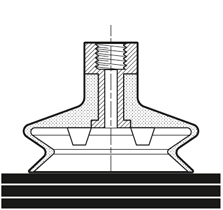1- Approach
 For a shock-free contact with the surface to be gripped, and to configurate to its shape, the suction pad in this instance has 1.5 bellows.
For a shock-free contact with the surface to be gripped, and to configurate to its shape, the suction pad in this instance has 1.5 bellows.
2- Gripping
 Vacuum is then applied to the suction pad, which lifts the object pushed by atmospheric pressure.
Vacuum is then applied to the suction pad, which lifts the object pushed by atmospheric pressure.The suction pad and the object then remain binded together throughout the entire process (transfer, packaging, etc).
3- Release
 At the end of the suction process, the vacuum is interrupted to release the object.
At the end of the suction process, the vacuum is interrupted to release the object.Most often, an air blow-off will help this process and avoid sticking. This also helps to quicken the move to the next cycle.
Vacuum levels and suction pad sizing

In practice, the majority of surfaces requiring suction are not air-tight. If the material is porous or the surface is rough, it is inevitable that air will escape into the vacuum through the material or under the edges of the suction pad. In this situation, a high flow of vacuum must be maintained to compensate for air leaks and to maintain gripping. This can be done economically and efficiently at a low level of vacuum.
Within the recommended vacuum range of 30% to 80%, two distinct zones must be distinguished, depending on the nature of the object to be gripped.
1 - Porous materials
The 30 to 55% vacuum zone is both economical and efficient, given the amount of vacuum flow required. The suction pads should be of the appropriate size to obtain the required gripping efforts.
2 - Air-tight surfaces
In this case, the 55 to 80% zone gives excellent results. The resulting effort is higher (curves opposite), so that more compact suction pads may be used.
